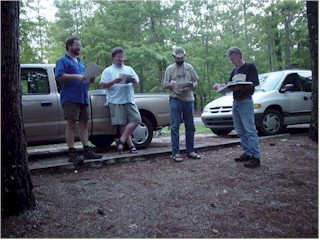
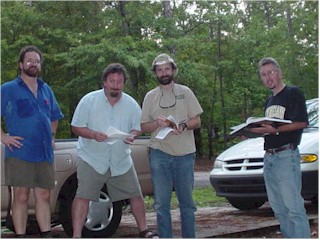
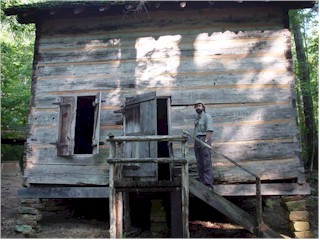
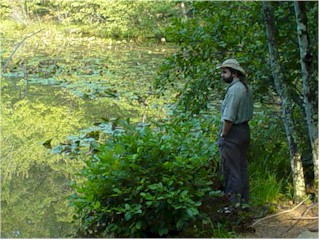
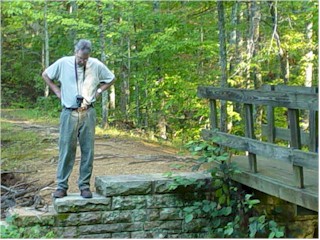
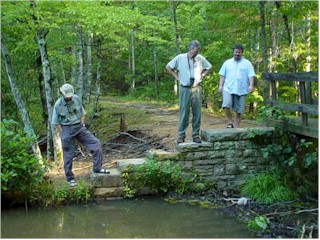
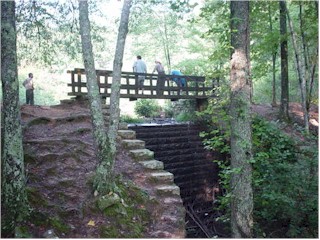
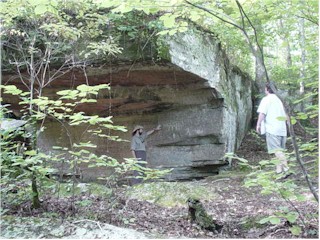
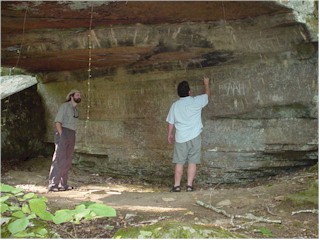
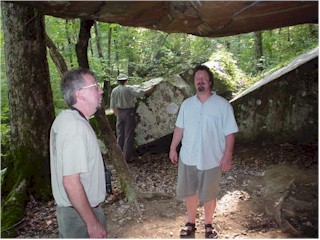
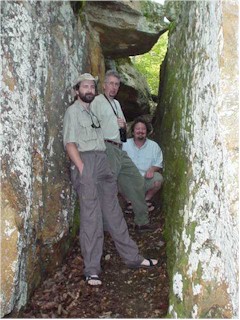
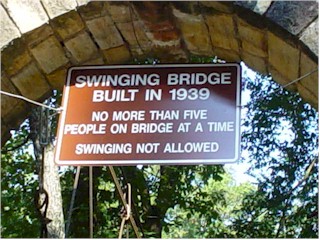
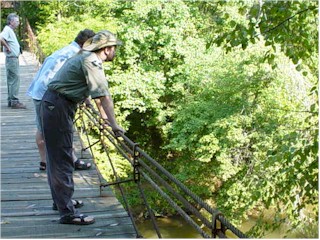
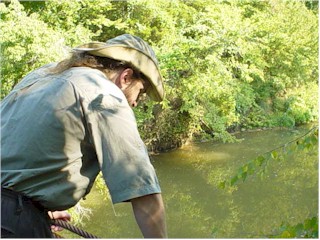
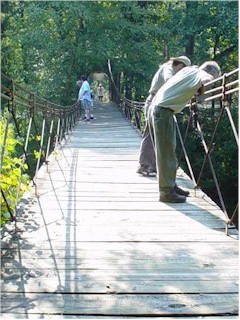
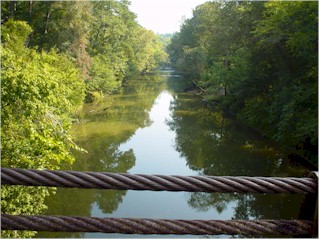
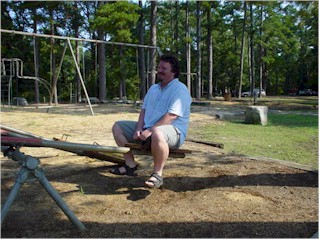
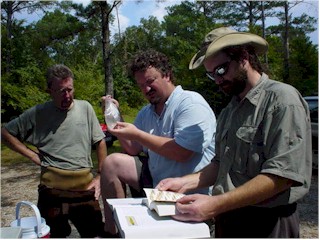
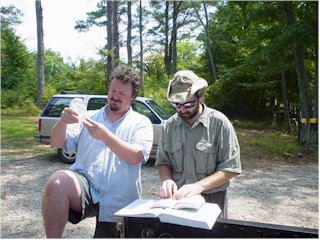
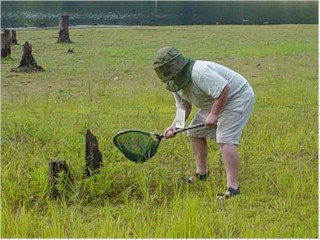

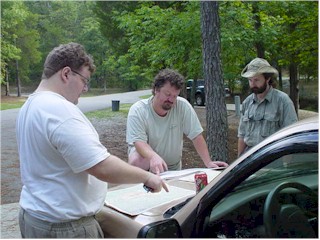

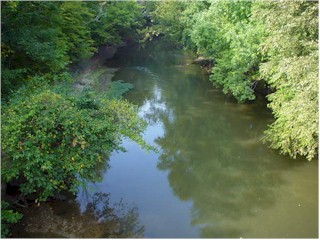
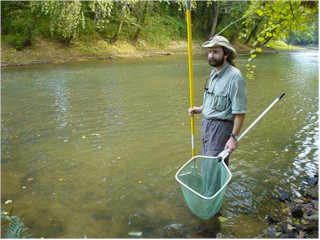
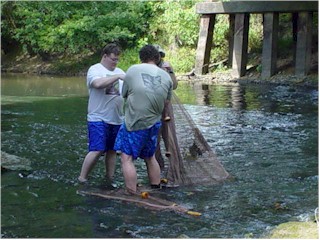
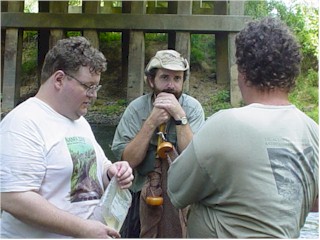
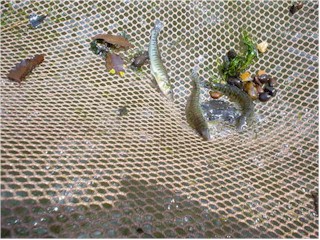
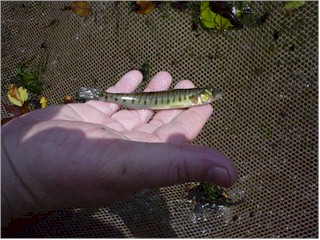
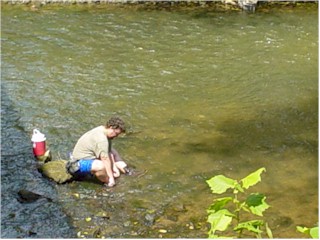
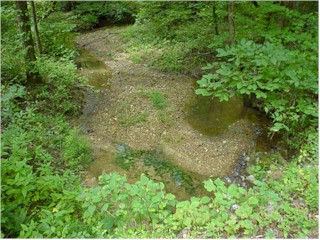
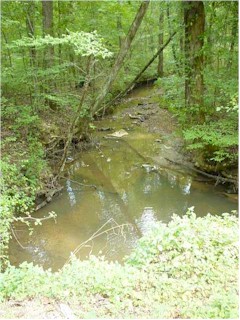
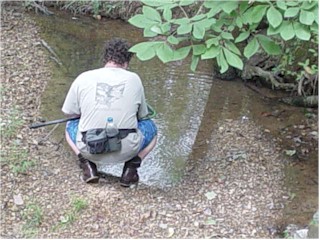
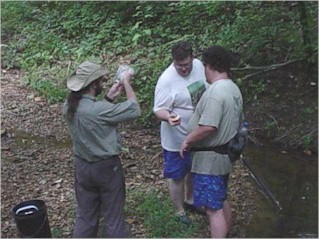
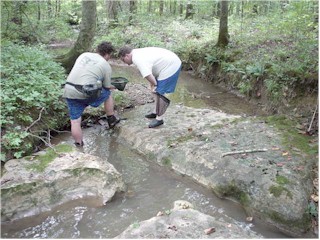
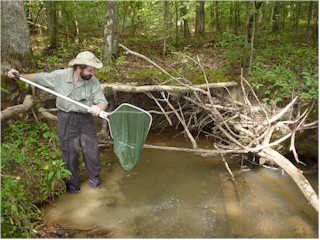
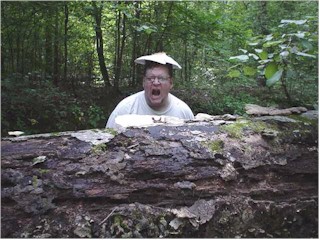
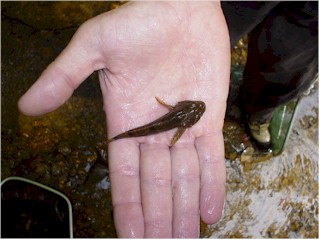
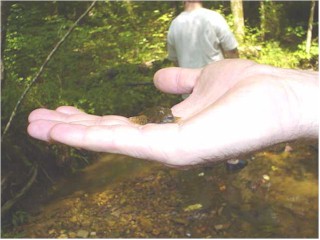
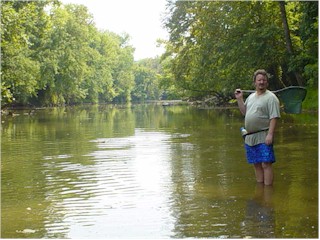

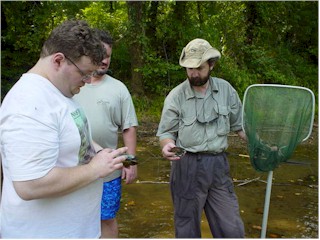
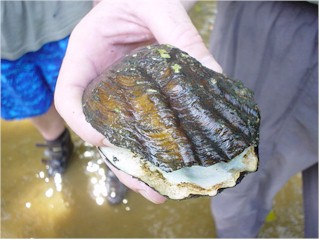
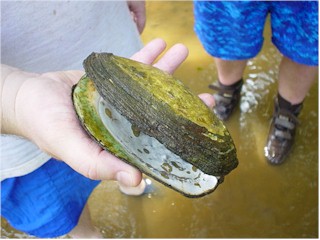
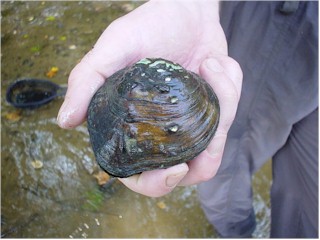
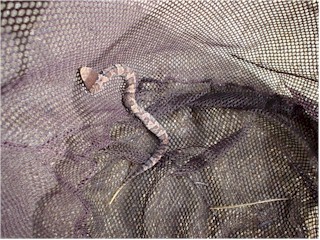
 |
After chilling out for most of Friday afternoon and evening, Martin Moore (host, MS), Casper Cox (TN), Ranger Bob (TN) and Steven Ellis (GA) make trip preparations Saturday morning. We were expecting Stott Noble (AL) to show up that afternoon, and Bruce Stallsmith that morning (we missed his email stating that he wouldn't be there - what a schmuck!) |
 |
It's only Saturday and Casper is already hamming it up for the camera! It was to be a preview of things to come... |
 |
Ranger Bob inspects an 1800's era log cabin at Tishomingo State Park. We were killing time until Bruce (our esteemed President) showed up, and the park had some interesting features. Sadly, Stott, who did not arrive until later that afternoon, missed all the great sights! We were all impressed by the craftsmanship that went into this supposedly primitive cabin. |
 |
Ranger Bob again, enjoying a very fishy looking lake upstream from the log cabin. |
 |
Steven Ellis peers over the edge of a rather deep channel. Beavers, apparently unsatisfied with the dam mankind had thoughtfully provided, felt obliged to add their own "improvements". |
 |
Another view on the lake side of the dam. To the lower right you can see the beaver's efforts. Bob and Casper are also enjoying the animals' handiwork. "Hey, snag that beaverstick!" |
 |
The other side of the dam. As you can see it is quite a precipitous drop. |
 |
A short hike uphill from the cabin and dam led us to an interesting rock formation. It would have made some hobo a nice home if the park rangers didn't run him off. |
 |
Casper makes his mark on the pristine, unspoiled rock surface. |
 |
Casper and Steven enjoy the shade provided by the rock. The day's weather proved to be excellent - not too hot, not too cool. When Steven and I first arrived at the park we were greeted by a furious thunder/hail storm. My clothes and sleeping bag got soaked! The wind was so fierce it drove enough water under the lid of my cooler (wherein my sleeping bag was stored) to fill it three inches deep. Fortunately we enjoyed great weather the rest of the weekend, and the park had a coin-op dryer. |
 |
Another interesting rock formation. |
 |
The entrance to the swinging bridge. If you can't swing on it, what's the point? |
 |
Ranger Bob and Casper look down at Bear Creek. This would have been a good collecting site, but that part of the creek was on park grounds so we couldn't collect there. We did collect at another part of Bear Creek the next day. |
 |
Ranger Bob looks down. It's a long way down - I wonder what he is thinking? We were discussing the fact that we knew people who had jumped into water from that height. |
 |
An overview of the swinging bridge. As you can see, it's quite long. Nobody paid much attention to the five-person limit. |
 |
Bear creek, from the bridge. |
 |
Casper wasn't posing for this one. I don't think he meant to get caught on camera! |
 |
At our first stop of the day. We got lost on the back roads and ended up at a dead end on Pickwick Reservoir. We were parked in some lucky guy's yard looking over our map, when he came out of the house and volunteered the information that there was a natural spring nearby on his property. He gave us permission to collect in the spring. It was clear and cold, and chock full of southern redbelly dace (Phoxinus erythrogaster)! The spring emptied into the lake after a short distance, where we captured and inland silverside (Menidia beryllina). Evidently this fish didn't realize it wasn't supposed to occur in that drainage... |
 |
And so began the first argument of the day..."It's a blackside darter/No, it's a dusky darter/No, see, this one has three spots at the base of the tail/Yeah, but it ALSO has red on this fin/Well, it doesn't really look like..." Um, can we leave yet, guys? We did actually find some creek chubs which we ID'd right off! But some of the juveniles I was calling scarletfins turned out to all be SRBD. |
 |
It wasn't all fun and games. The threat of the dreaded West Nile Virus loomed ever near, and Casper was taking no chances! Well, almost none... |
 |
We sampled two other sites Saturday, but because we were having so much fun I didn't take any more pictures. Plus, I didn't want to dunk my fairly new digital camera in the drink. But when we arrived back at base camp, we found Stott Noble waiting patiently for us, after having already done some of his own sampling - what was to have been our supper. He was paid back when his six-pack of long-neck buds disappeared that evening. Stott found out the hard way that the Alabama gazetteer does not show the names of Mississippi roads. We had a hard enough time when we DID know the names! |
 |
Sunday - a new day begins. We decide to scrap our planned Bear Creek canoe trip and just do some more collecting, since everybody wanted to be on the raod before 3:00 PM. The Natchez Trace Parkway is very nice to drive on, but you can't see much of it at night! Here we are finalizing our next two sites before loading up the vehicles with nets, seines, and implements of destruction. Steven departed that morning claiming he needed "sleep", but the rest of us proceeded undeterred. |
 |
The obligatory upstream shot of Bear Creek from the bridge... |
 |
...and downstream, where it didn't look so inviting. We did catch several gilt darters in the riffles upstream, which were destined for the Mississippi Museum of Natural Science. We seined long and hard for 6 gilt darters (Percina evides). Bob let one slip through his fingers after having unceremoniously chunked Casper's prized weed shiners (Notropis texanus) and would have never lived it down had not Casper let another gilt escape him in exactly the same manner, not 5 minutes later! I counted four gilt darters in my cooler, but when I arrived home I could only find one. I smell something fishy here... |
 |
Bob looks suitably guilty after losing the weed shiners and gilt darter. The net with the long yellow handle is my prototype "perfect dipnet" which I have used for the last few years. The handle telecopes out to 12 feet, and the bright yellow color makes it easy to find if you drop it in the water. If only it floated... |
 |
Stott, Ranger Bob, and Casper try to prevent another escape... |
 |
OK guys, let's rehearse what went wrong THIS time! Casper, the fish goes IN the bucket. Stott, try not to jiggle the net so much! And keep the lead line DOWN. |
 |
We decided to do one last haul before leaving the site. When we pulled up the net, four voices exclaimed simultaneously, "LOGPERCH!" |
 |
They were stunningly beautiful. |
 |
Casper wrestles with his new wading boots yet again. They plagued him the entire time, as the velcro refused to stay stuck together. |
 |
This small tributary to Cedar Creek was our last site of the trip. It was clear and cool, and proved to be a haven for the third of my target species - rosyside dace (Clinostomus funduloides). |
 |
Another view of the tributary showing various habitat structures |
 |
The bottle on Casper's back is how he holds fish when he's on the water. The small mouth of the bottle was the main contributing factor to losing the two gilt darters! But the system does have its advantages - mainly portability. |
 |
Ranger Bob tries to ID a shiner imprisoned in Casper's omnipresent crinkly baggie, while Casper and Stott discuss mushrooms. I was the only one present who neither particularly liked mushrooms nor knew ALL about them. Besides fungi, Ranger Bob also displayed a startling knowledge of local flora. |
 |
This cleft boulder yielded some very nice rosysides. We found that a "gang" attack with dipnets was the best way to capture them. I took home 6 of the largest ones, but by the time I got them home it was obvious that they were not doing well. Over the next couple of days I lost all of them, the only casualties of the trip. Their pitiful carcases joined their brethren in Andy Borgia's bottle-O'-fish. |
 |
This deep undercut proved too challenging for a mere dipnet. |
 |
Stott demonstrates that fungi make great outdoor hats, as well as on-the-spot meals! |
 |
A sculpin (Cottus carolinae) was willing to pose for this photo, |
 |
The business end of said sculpin. This is the only Cottid known to occurr in Mississippi, and it is found only in the Tennessee River drainage within the state. |
 |
Cedar Creek proper, where we emerged from the tributary. |
 |
Y'r most obt. svt. (to quote Chris Scharpf) |
 |
Cedar Creek yielded some nice mussel shells too. Lots of states don't even let you take the shells, so we didn't take any chances and left them where we found 'em. Turns our Ranger Bob knows mussels too... |
 |
A three-ridged mussel? |
 |
I forget what he called this one. |
 |
A pimpleback - that one's easy to remember! |
 |
"Hey, what kind of snake have you got there?" |
I could have included an exhaustive list of species we captured, but the only really remarkable ones were the SRBD and rosysides and the gilt darters, all three of which were my targeted species when we set out. We did find two fishes outside their known range (or at least their known drainages) - an inland silverside and several Fundulus stellifer. A grand time was had by all. My next planned trip will be to the Pascagoula River system, principally the Leaf and Chickasawhay rivers. The Pascagoula is the only remaining large undammed river in the southeast. Stay tuned for details!